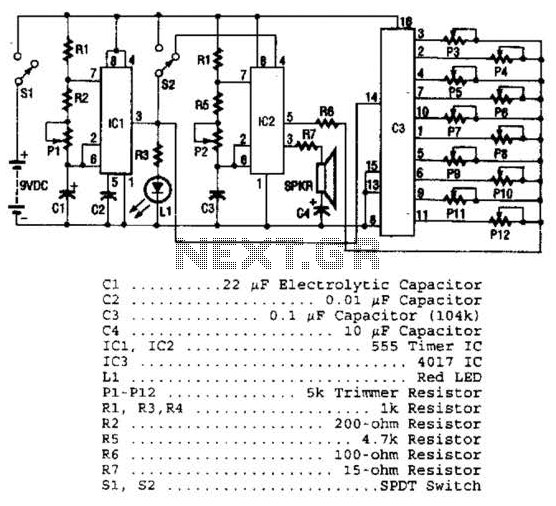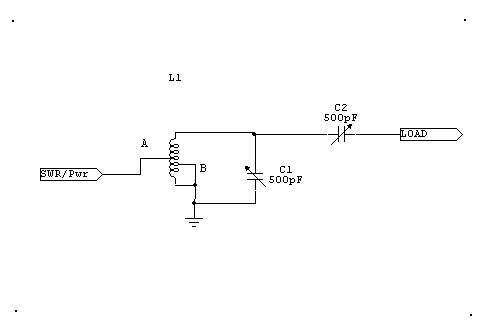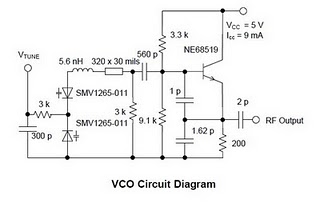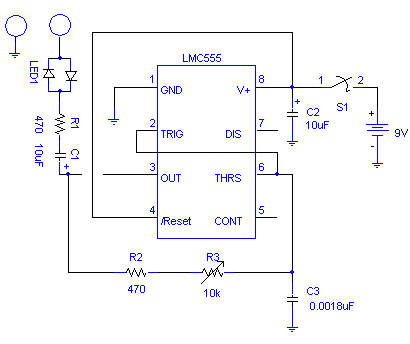
8 Note Tune Player
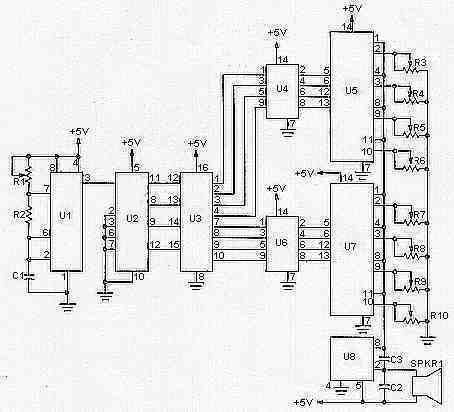
This neat little circuit can play 8 note tunes at any speed you want. You select the notes with 8 trim pots. The speed is selected through a ninth pot. The circuit draws very little power and can be powered by a 9-volt battery, with the addition of a 7805 regulator to power the TTL logic used. More: R1 controls the speed at which the notes are played. R3-R10 control the pitch of those notes. The circuit will operate fine on a 9V battery, with the addition of a 7805 regulator to power the TTL logic used. The missing pin on U2 is pin 14.
The circuit described is a simple musical tone generator that utilizes a series of potentiometers (trim pots) to allow for user-defined note selection and speed adjustment. The circuit is powered by a 9-volt battery, which is a common and convenient power source for small electronic projects. The inclusion of a 7805 voltage regulator is crucial, as it steps down the 9V supply to a stable 5V output, which is suitable for powering TTL (Transistor-Transistor Logic) components used in the circuit.
In this design, R1 functions as a variable resistor that adjusts the playback speed of the generated tones. By varying the resistance, the timing of the sound output can be altered, allowing for a range of speeds from slow to fast. The other resistors, R3 through R10, are also variable and are used to set the pitches of the individual notes. Each of these trim pots corresponds to a specific note, enabling the user to create melodies by selecting different combinations of pitches.
The circuit's architecture likely includes a microcontroller or a dedicated sound generation IC, which interprets the resistance values from the trim pots and produces the corresponding frequency outputs. The mention of pin 14 on U2 suggests that this component is integral to the circuit's operation, possibly being a timer or oscillator responsible for generating the audio frequencies. Ensuring that all pins are correctly connected is essential for the circuit to function as intended.
Overall, this circuit design is efficient and user-friendly, making it suitable for hobbyists and educational purposes. It demonstrates fundamental principles of sound synthesis, electronic component interaction, and power management within a compact setup.This neat little circuit can play 8 note tunes at any speed you want. You select the notes with 8 trim pots. The speed in selected through a ninth pot. The circuit draws very little power and can be powered by a 9 volt battery, with the addition of a 7805 regulator to power the TTL logic used. # R1 controls the speed at which the notes are played. R3-R10 control the pitch of those notes. # The circuit will operate fine on a 9V battery, with the addition of a 7805 regulator to power the TTL logic used. # The missing pin on U2 is pin 14. 🔗 External reference
The circuit described is a simple musical tone generator that utilizes a series of potentiometers (trim pots) to allow for user-defined note selection and speed adjustment. The circuit is powered by a 9-volt battery, which is a common and convenient power source for small electronic projects. The inclusion of a 7805 voltage regulator is crucial, as it steps down the 9V supply to a stable 5V output, which is suitable for powering TTL (Transistor-Transistor Logic) components used in the circuit.
In this design, R1 functions as a variable resistor that adjusts the playback speed of the generated tones. By varying the resistance, the timing of the sound output can be altered, allowing for a range of speeds from slow to fast. The other resistors, R3 through R10, are also variable and are used to set the pitches of the individual notes. Each of these trim pots corresponds to a specific note, enabling the user to create melodies by selecting different combinations of pitches.
The circuit's architecture likely includes a microcontroller or a dedicated sound generation IC, which interprets the resistance values from the trim pots and produces the corresponding frequency outputs. The mention of pin 14 on U2 suggests that this component is integral to the circuit's operation, possibly being a timer or oscillator responsible for generating the audio frequencies. Ensuring that all pins are correctly connected is essential for the circuit to function as intended.
Overall, this circuit design is efficient and user-friendly, making it suitable for hobbyists and educational purposes. It demonstrates fundamental principles of sound synthesis, electronic component interaction, and power management within a compact setup.This neat little circuit can play 8 note tunes at any speed you want. You select the notes with 8 trim pots. The speed in selected through a ninth pot. The circuit draws very little power and can be powered by a 9 volt battery, with the addition of a 7805 regulator to power the TTL logic used. # R1 controls the speed at which the notes are played. R3-R10 control the pitch of those notes. # The circuit will operate fine on a 9V battery, with the addition of a 7805 regulator to power the TTL logic used. # The missing pin on U2 is pin 14. 🔗 External reference
